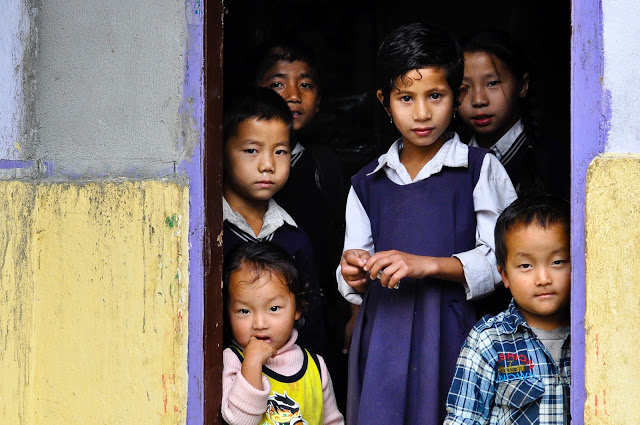The Lepchas, the indigenous people of Sikkim, are shaken up. Many consider the earthquake of September 2011 and the destruction caused at sites of the Teesta dam project in their homeland, Dzongu, in north Sikkim, as a sign of the wrath of the gods for disturbing the sacred ecology of this unique Himalayan landscape.
There are only about 4,000 Lepchas — a ‘primitive tribe’ as recognised by the state and ‘original indigenous inhabitants’ as acknowledged by the Indian Supreme Court — still living in Dzongu. They consider themselves protectors of this amazing ecosystem at the foothills of the main deity, Khangchendzonga, the world’s third highest mountain. It is their relationship with the mighty mountain and ancient legends of the natural world they live in that is at the heart of their agitation.
For the past seven years, local inhabitants have been questioning the Teesta hydropower project and actively protesting against the 24 dams being built on the Teesta river, which flows from India into Bangladesh. Many have undertaken 100-day hunger fasts demanding that Dzongu be spared.
Dzongu is an earthquake-prone and geologically fragile area; blasting and tunnelling in the mountains to change the course of rivers is not the cleverest way to generate electricity, say the Lepchas. They have quoted from climate change studies questioning the long-term carrying capacity of dams on the Teesta, given the rate of glacier melt and changes in weather patterns. They have pointed out that Dzongu, all of its 74 square kilometres of vertical terrain, is an important part of the Khangchendzonga National Park and that any conservation effort in these parts would be pointless without protecting Dzongu. They have listed the myriad species of butterflies, birds, plants and trees that survive in these mountains that constitute part of a greater Indo-Myanmar biodiversity hotspot. Tired, thirsty and hungry, they shouted their protests before being arrested and force-fed. No one paid any attention to their warnings.
News of the earthquake and aftershocks therefore came as no surprise. The Bongthings, Lepcha shamans, had already warned that the gods were angry. Khangchendzonga was disturbed and the almighty mountain was bound to demonstrate its power. And it did. For many, the fact that a majority of deaths happened in tunnels and at sites of the Teesta hydropower project was a sign that the spirit of the great mountain was aroused and aware of the wounds that were being inflicted on its sides.
The earthquake has managed to convert the most strident of pro-dam residents. Even those who until a few months ago were angling for jobs and benefits from the project have changed their tune. Dzongu, after the earthquake, has been truly shaken up.
Meanwhile, temperatures in India’s northeast region are set to increase by 1.8 to 2.1 degrees Celsius in the next two decades, according to the Ministry of Environment and Forests. The impact of climate change is likely to be particularly acute in this region on account of the fragility of the ecology, economic backwardness, and richness of threatened and endemic species, says an assessment done by the Indian Network of Climate Change Assessment (INCCA).
Biodiversity is intrinsically linked to weather patterns. Consequently, changes in weather patterns have a huge impact on the habitats of species within the ecosystem. Wetlands, grasslands and tropical rainforests are extremely vulnerable to habitat loss, loss of endemic species and the proliferation of invasive species.

According to biodiversity records, Sikkim supports nearly 50% of India’s key vertebrate and invertebrate species, over one-third of which are endemic. The vulnerability of ecologically fragile species like lichens, orchids, insectivorous plants that occupy specific and narrow niches, is considerable.
In the past, conservation efforts focused on protecting large and conspicuous species like the tiger, elephant and panda. And it is true that by setting aside areas large enough to support viable populations of large hungry species, we also ensure the survival of a great many smaller, less conspicuous plants and animals. But the threat posed by dams and ancillary development does not just affect individual species like the snow leopard but also a host of interdependent communities of plants and animals. Dzongu is a prime example of why the entire ecosystem, including its human inhabitants, needs to be protected.
Biodiversity refers to total genetic diversity among individuals, populations and species. Conservation aims to save the diversity of life by protecting as many species as possible, as well as preserving populations of individuals large enough to encompass the full range of individual genetic variations among members of these populations. The INCCA study predicts changes in stream flow, floods, drought, water temperature, and water quality due to climate change.

The Teesta and its tributaries that are being dammed, including Rongyoungchu river in Dzongu, is the lifeline of the ecology of Khangchendzonga. She is the mother river of Sikkim, says Lingtheng Bongthing. “Damming the Teesta, messing with her trajectory, arresting her flow, will cause a lot of destruction,” he warns. “The dams will not deliver on their promise; that much is clear. But the degradation caused by blasting, tunnelling and trucking thousands of tonnes of mountain around will have a profound impact on the environment,” says filmmaker Dawa Lepcha who spearheaded the hunger strike. “Environmental degradation threatens everyone, from banker to farmer. It undermines the very foundation of our economic wellbeing, threatening not only future prospects for development but perhaps even our ability to survive,” concludes former forest minister of Sikkim, Athup Lepcha. Kachyo Lepcha, a storyteller and university lecturer, asks: Why can’t India spare Dzongu? How many such places are left in our country?
Shailendra Yashwant is a senior photojournalist who has worked with The Hindu, Outlook and The Independent
This article is the first of a two part series that won second prize in the All India Environmental Journalism Competition organised by the thethirdpole.net, Deutsche Gesellschaft fuer Internationale Zusammenarbeit GmbH (GIZ) and the Forum of Environmental Journalists of India. It was first published on www.infochangeindia.org.
